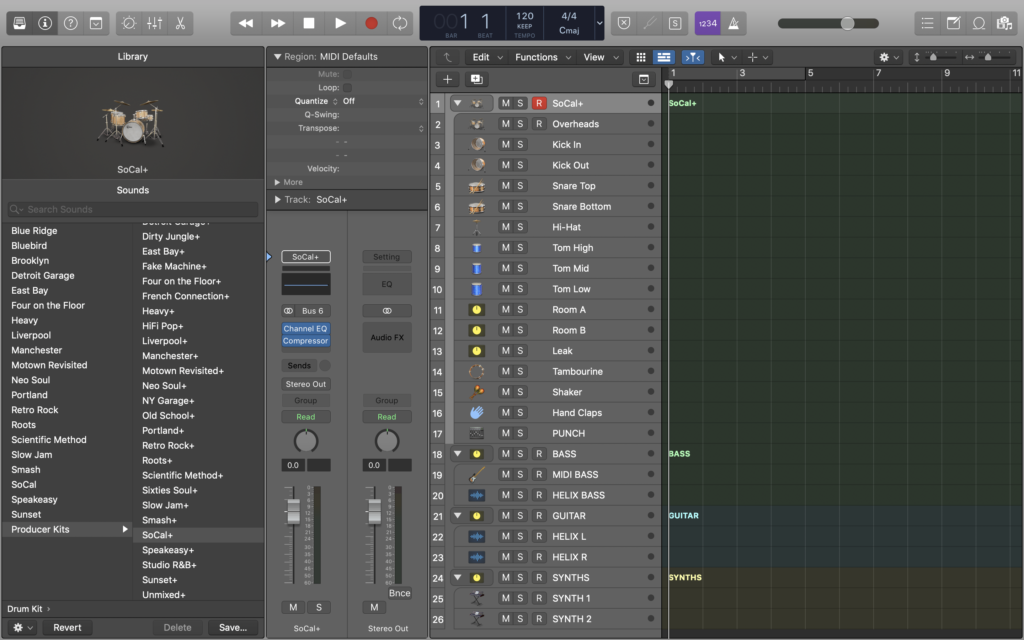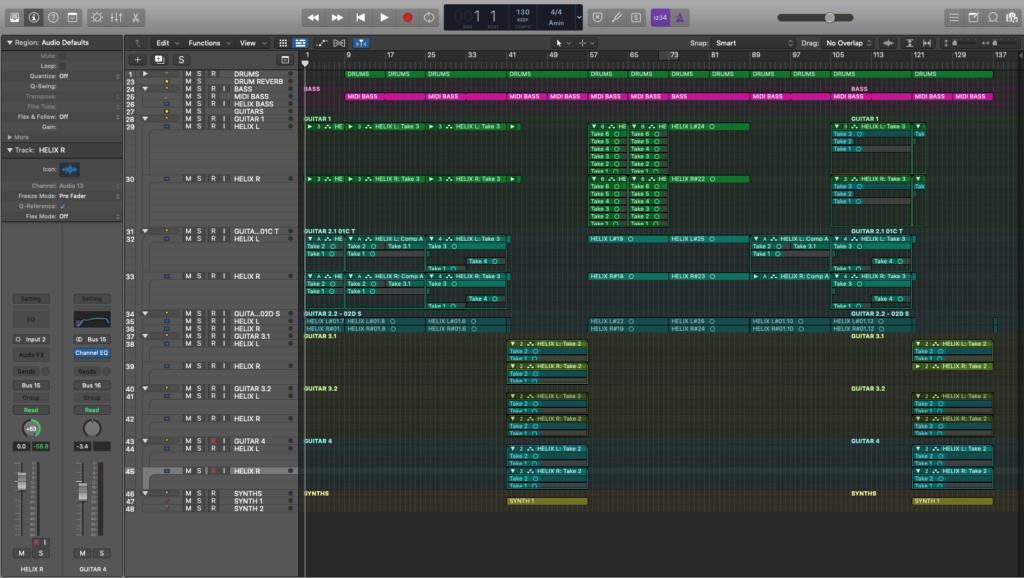Hello!
It has been a while since I’ve updated this blog, so I thought it might be a welcome break from my work towards my dissertation to write a post.
To that end, I’m going to write a post about an album released last Friday, 11th March – IMPERA. The Album is the 5th by Swedish band Ghost, and one I have eagerly anticipated since its announcement. It is said to be written about the “rise and fall of empires” and having listened several times already, I thoroughly enjoy it. I guess you could call it a review of sorts but it’s really more of a reflection on it. I’m going to go through the album track by track and write as I listen to it.
The album begins with an instrumental introduction track – Imperium. With a military-sounding march on the snare drum accompanied by soaring guitar harmonies, it introduces the theme of empires well and sets the atmosphere brilliantly for the album. It’s only 1 minute and 40 seconds long, so I don’t have time to write any more. Great intro. 8.5/10.
The first real song Kaisarion follows. It starts with an awesome harmonised guitar part and an insanely strong vocal scream before Papa’s first line of the album – “Kaisarion, a prophecy told, we’re building our empire from the ashes of an old. For me, the real highlight of this song is the pre chorus. The vocal line is incredibly catchy and the arpeggiated lead guitar and drumming is reminiscent of 80s metal bands such as Iron Maiden. Really brings in a high energy and gets you excited for the album. Both verses are strong and the vocal work is, as usual, impeccable by Tobias Forge. The choruses are powerful and will be sung passionately by thousands of fans during the live shows, probably opening the set as ghost usually open with the first track from whichever album cycle they are on. There’s a heavier breakdown/guitar solo section which ups the energy and anticipation again, before both the pre choruses play back to back, slowly building up to the final chorus. Overall, this is already one of my all-time favourite ghost songs. 10/10
Track 3 is entitled Spillways. My initial reaction to this was concern, as I heard the piano intro and thought “this isn’t really ghost.” But then the vocals start, outstanding backing vocals are a trend on this album and this song is no different. Then the chorus comes and this is an instant classic. “Its the cruel beast that you feed, its your burning yearning need to bleed”. The second verse is stronger than the first lyrically, but the highlight again is the backing vocals in “such a ride”. The arrangement is slightly different in the second chorus, which keeps the listener engaged, before a very traditional ghost guitar solo. Nothing too complex or shreddy, just brilliant melodies and harmonised guitars. It’s a shorter song, just over three minutes in runtime, but is overall a very good performance and could easily be a live staple for the band. 8.5/10
The second single for the album, Call Me Little Sunshine, follows. A slower tempo and drumming which is kept nice and simple set a great base that is sort of reminiscent of AC/DC tracks such as Hells Bells – The 80s influence on the album is clear again here. The best part of this song is the production. Every instrument sounds brilliant and they all gel together so well to create a cohesive, exciting sound for the whole song – every part of the song has a clear, well defined purpose. The clearly We Will Rock You – inspired drums work well towards the end of the song, especially with the outstandingly clean drum production. All of this alongside the eerie vocal harmonies and beautiful chord progression make for a brilliant song, which fits right in on the album. 9/10
The first single follows the second. Hunter’s Moon has been out for several months now and has impressed me since its release. From the goth-abba sounding pre chorus, to the catchy lead guitar lines and driving verses, with that outstanding guitar/drum fill at the end of the first line in the second verse. Halfway through the song, the listener is rewarded with exactly what you want, a heavy riff section with choral vocals in the background – a signature ghost sound – before a short guitar solo and the vocals return before we drop back into the chorus with just the vocals for a second and some great production, then everything comes back in to end the song superbly. It’s not a long song so I don’t have the time to go into detail before the next track, but it is brilliant. 9.5/10
Track 6 – Watcher In the Sky. This song is incredible. A great riff and four on the floor bass playing in the intro before a really properly Ghost-sounding verse reminiscent of their first album Opus Eponymous. The pre-chorus and chorus are more familiar to newer Ghost releases, but this is one of the few times it really feels like Tobias Forge starts to push his force, the strained sound in “Communication is Key” is something you don’t hear much in Ghost’s music and is a welcome change. The chorus is simple and easy to sing along to, yet still is brilliantly entertaining. The vocal production throughout is top-notch again, and is really highlighted in the bridge. The guitar solo serves the song beautifully and this line continues into the chorus really nicely. This song would be one of Ghost’s best to date if it wasn’t for the fade out at the end, which is disappointing – a song like this deserves a proper ending, so this loses the song marks. 8/10 (would’ve been 9 without the fadeout)
The third instrumental – Dominion comes next. It’s eerie and introduces the second half of the album, it hints towards a change in mood after the majestic Watcher in the Sky and there’s not really much else to say about it. 7/10
The final single, Twenties, is both very dark but also sounds weirdly uplifting. With thrash-metal sound, the 80s influence on the album is again clear, and the lyrical content is interesting, clearly referencing facism/nazism in the 1920s, but also a clear reference to Forge’s opinions on certain leaders in the modern day – “We’ll be grabbing them all by the hoo-has.” Musically, its a great track and another clear sing-along which you’d expect the band to play live. With soaring guitar lines once again and a catchy, fun chorus, its a great song. 8.5/10.
Darkness at the Heart of my Love is a break from the intensity you experience in the rest of the album. Beautiful guitar and vocal melodies throughout are thoroughly enjoyable, and the chorus is powerful and uplifting, it almost sound like a love song. The triplet guitar riff is great throughout – a great layer for the rest of the song to exist around. I don’t really know what else to say about this song. It’s a good break from the intensity of the rest of the album and probably one that people unfamiliar with Ghost’s distinctive style would really be able to enjoy. Although it’s a great song, it is unfortunately overshadowed by what follows. 8/10
Griftwood is a brilliant song, and it being over 5 minutes long is probably the only thing that stopped it from being a single. The song is unapologetically Ghost in nature and this album’s outstandingly strong backing vocals are once again a highlight. The chorus is once again brilliant and can be instantly sung along to. It really sounds like a future arena-rock classic. The guitar solo starts with an awesome run before sitting back into classic Ghost guitar harmonies with just a hint of shred. The solo is kept fairly short, with just enough before bringing the listener back into the pre chorus and chorus – the clear highlight of the track. The stereotypical pop key change of going up in the final chorus isn’t something I always enjoy but it works to perfection here, giving the song a great culmination. 10/10
Bite of Passage is the final instrumental track. Only 31 seconds long but sets an eerie tone for the finale of the album with its guitar lines and has a lovely transition into the final track. 8/10
Respite on the Spitalfields closes IMPERA. The pre chorus is really good and the chorus is pretty good too, however this song remains the weakest on the album. The playing is great and the production is outstanding once again, but for me the level of song writing just doesn’t quite match up to the rest of the album. The song has great elements to it but isn’t quite cohesive enough to be one of IMPERA’s stand-out cuts. The lyrical content is interesting too – clearly about Jack the Ripper and the line “One day he will come back from the bowels of hell” is an eerily satanic statement – possibly about the next ghost release being a return to the darker nature of the first two albums. The fact it has a fade out is disappointing again, but one thing about this song that is great is the return to the guitar motif from Imperium, the first track. It reminds the listener of the journey you have been on throughout the album and provokes thought about it as a whole, while being a sort of glue that holds the album together. This idea of bringing back motifs at the end of the album is not new to Ghost. They did the same thing on their last album, Prequelle, Bringing back an organ part from towards the front of the album as a vocal melody in the final track Life Eternal. Overall, its a good song, but still the weakest on the album. 6.5/10
So there you have it, my thoughts on Ghost’s fifth album, IMPERA. Overall, I think its a great album and I’m really looking forward to seeing how its incorporated into their live shows in the upcoming UK tour. Well worth a listen, with outstanding production and moments of genius dotted throughout. Overall rating – 9.5/10



